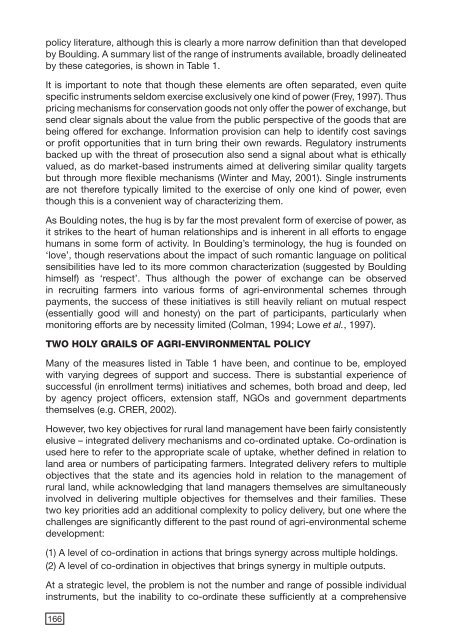Download as a PDF - CiteSeerX
Download as a PDF - CiteSeerX
Download as a PDF - CiteSeerX
Create successful ePaper yourself
Turn your PDF publications into a flip-book with our unique Google optimized e-Paper software.
policy literature, although this is clearly a more narrow definition than that developed<br />
by Boulding. A summary list of the range of instruments available, broadly delineated<br />
by these categories, is shown in Table 1.<br />
It is important to note that though these elements are often separated, even quite<br />
specific instruments seldom exercise exclusively one kind of power (Frey, 1997). Thus<br />
pricing mechanisms for conservation goods not only offer the power of exchange, but<br />
send clear signals about the value from the public perspective of the goods that are<br />
being offered for exchange. Information provision can help to identify cost savings<br />
or profit opportunities that in turn bring their own rewards. Regulatory instruments<br />
backed up with the threat of prosecution also send a signal about what is ethically<br />
valued, <strong>as</strong> do market-b<strong>as</strong>ed instruments aimed at delivering similar quality targets<br />
but through more flexible mechanisms (Winter and May, 2001). Single instruments<br />
are not therefore typically limited to the exercise of only one kind of power, even<br />
though this is a convenient way of characterizing them.<br />
As Boulding notes, the hug is by far the most prevalent form of exercise of power, <strong>as</strong><br />
it strikes to the heart of human relationships and is inherent in all efforts to engage<br />
humans in some form of activity. In Boulding’s terminology, the hug is founded on<br />
‘love’, though reservations about the impact of such romantic language on political<br />
sensibilities have led to its more common characterization (suggested by Boulding<br />
himself) <strong>as</strong> ‘respect’. Thus although the power of exchange can be observed<br />
in recruiting farmers into various forms of agri-environmental schemes through<br />
payments, the success of these initiatives is still heavily reliant on mutual respect<br />
(essentially good will and honesty) on the part of participants, particularly when<br />
monitoring efforts are by necessity limited (Colman, 1994; Lowe et al., 1997).<br />
TWO HOLY GRAILS OF AGRI-ENVIRONMENTAL POLICY<br />
Many of the me<strong>as</strong>ures listed in Table 1 have been, and continue to be, employed<br />
with varying degrees of support and success. There is substantial experience of<br />
successful (in enrollment terms) initiatives and schemes, both broad and deep, led<br />
by agency project officers, extension staff, NGOs and government departments<br />
themselves (e.g. CRER, 2002).<br />
However, two key objectives for rural land management have been fairly consistently<br />
elusive – integrated delivery mechanisms and co-ordinated uptake. Co-ordination is<br />
used here to refer to the appropriate scale of uptake, whether defined in relation to<br />
land area or numbers of participating farmers. Integrated delivery refers to multiple<br />
objectives that the state and its agencies hold in relation to the management of<br />
rural land, while acknowledging that land managers themselves are simultaneously<br />
involved in delivering multiple objectives for themselves and their families. These<br />
two key priorities add an additional complexity to policy delivery, but one where the<br />
challenges are significantly different to the p<strong>as</strong>t round of agri-environmental scheme<br />
development:<br />
(1) A level of co-ordination in actions that brings synergy across multiple holdings.<br />
(2) A level of co-ordination in objectives that brings synergy in multiple outputs.<br />
At a strategic level, the problem is not the number and range of possible individual<br />
instruments, but the inability to co-ordinate these sufficiently at a comprehensive<br />
166

















